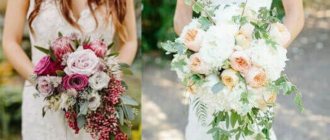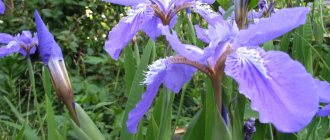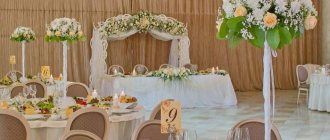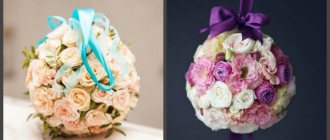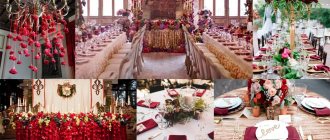For a long time, chrysanthemums were undeservedly considered “unworthy” of proximity to the queen rose. However, it is the most common flower of the Eurasian continent, native to China, where it is still used in alternative medicine. Initially, it migrated to Japan, where it was rightfully recognized as a symbol of the imperial house. In the 17th century, the chrysanthemum was brought to Europe, and by the mid-19th century to Russia.
The combination of white roses and chrysanthemums of various colors in one bouquet looks elegant and colorful. In Japan, the yellow “golden-colored” chrysanthemum is included in the national symbols, where it is depicted on coins, the country’s coat of arms, and the seal of the Imperial House.
In autumn, bouquets using chrysanthemums in combination with other flowers, cereals, and herbs become the most popular. It is unpretentious and retains its freshness and elasticity for a long time.
Bouquet of chrysanthemums and cereals
What to combine with
The most popular combination of chrysanthemums and roses. Used in the following tint tandems:
- Roses and chrysanthemums in white, cream, and pink shades are used for wedding compositions or as a gift to a young, sophisticated nature. This arrangement of flowers symbolizes innocence and purity.
- The combination of white and blue shades looks dynamic and catchy. Used for wedding ceremonies, when the rest of the paraphernalia includes blue and blue colors. It harmonizes well with a boutonniere in the same colors for the groom or when he is wearing a dark blue suit. The sapphire color in the bride's bouquet symbolizes fidelity and constancy of feelings.
- Green bouquets have begun to enjoy particular popularity, and breeders are helping with this. Tandems of light green roses and emerald chrysanthemums symbolize tenderness, youth, and the beginning of a new life. It is appropriate to give such a bouquet to a young mother in honor of the birth of a baby or to a charming girl when proposing marriage.
- The combination of white and yellow shades is often used in wedding ceremonies. Attributing subsequent separation and parting to the yellow color of the buds is becoming a thing of the past. The symbolism regarding this color turned towards the east. Bouquets with “golden” tones are presented as a gift to a woman or man with a hint of improved material well-being and a wish for longevity.
- The presence of white and red flowers in the bouquet suits girls with a catchy, expressive appearance. Deep red shades reflect the passion of nature and ardent temperament. But the use of exclusively bright tones in a composition can draw all attention to itself, which is why combinations of white chrysanthemums with red roses or vice versa are common.
Bouquet of red roses and white chrysanthemums
Bouquets of roses and chrysanthemums are diversified by including greenery and cereals. Good for this:
- asparagus;
- fern;
- bergrass;
- ruscus;
- aspidistra;
- Aralia.
The main thing to take into account is that there should not be too much greenery, unless it is the main active object in the bouquet. Wheat, rye, and other ripe ears are added to autumn compositions as a wish for abundance and fertility.
In addition to the choice of colors themselves, great importance is attached to their quantity. It is traditionally believed that large ones are counted by buds, and those in which the inflorescences are collected in baskets are counted by branches.
Today we will teach you how to make a beautiful bouquet of roses and chrysanthemums for someone dear to you
Choice of colors.
Choose the combination of colors you need, according to their symbolism. Bright flowers are a playful and spring option, while flowers in softer tones (beige and white, for example) are suitable for an elegant and romantic bouquet.
To create a good bouquet of roses and chrysanthemums, you must be picky about the quality of flowers. Pay attention to aspects such as flower diameter, absence of defects, fresh appearance and length of stems.
Composition of roses and chrysanthemums.
First, remove all the lower leaves, leaving only the flowers and the upper leaf surface. Don't forget to remove the thorns from the roses.
Once you have removed the leaves of the flowers, place them on the table to trim their stems to the desired length. Prepare and place green branches, for example, from fern. You can also use different textures like red St. John's wort, goldenrod, calendula, or ruscus berries. Take a vase or container in which the bouquet will be placed to make it.
Now take the chrysanthemums and fill the form (vase) with them, one by one. Stick roses between the chrysanthemums, but at least 3 pieces. Align the bouquet so that the roses are slightly higher than the chrysanthemums, since they are the main flowers in such bouquets. Finally add green leaves and/or other twigs around the dome of flowers.
Tie the bouquet tightly by the stems with a special cord sold at any florist store. Now you can trim the protruding stems so that the base of the bouquet becomes even.
That's all, you have made a beautiful bouquet of roses and chrysanthemums to decorate your home or for a gift.
Blue shades
When the task is set to create a bouquet of bright blue flowers, the question arises whether this plant has blue shades in its palette. In the early 2000s, Japanese scientists managed to develop blue chrysanthemums using genetic engineering. They achieved this by introducing the anthocyanin gene from the blue bell and clitoria (moth pea) into the DNA of the red flower. The plants obtained through this modification have buds in the color range from sky blue to deep indigo. However, the import of genetically modified plants into Russia is prohibited, so florists will not soon use “natural” blue flowers.
For now, to get blue flowers, you can use this method:
- Freshly cut chrysanthemums with dense flowers of white, light beige and soft cream shades are suitable for coloring.
- A packet of blue food coloring is diluted in a jar of cold water, stirring until no sediment remains. The density of the color will depend on the saturation of the solution and the time the plant spent in the liquid.
- Using a sharp floral knife, cut the stems of chrysanthemums at an angle of 45°.
- Make a longitudinal thin cut along the stem, carefully so as not to damage the structure of the stem.
- Place all prepared chrysanthemums in a jar for 8-20 hours, removing the branches when sufficient coloring occurs. The faster it is extracted, the lighter the shades.
During the painting period, the room should be light and warm, air humidity should be reduced to the maximum. When you want to get flowers of different shades on one stem, proceed as follows:
- the stem is split into several separate segments;
- each is placed in a separate container with dye of different concentrations;
- last for different times.
This achieves the effect of a transition of shades from sky blue to ultramarine on one branch, which looks like a full-fledged bouquet when decorated.
How to keep a bouquet fresh for a long time
When creating a composition using chrysanthemums and roses, pay attention to several features of caring for each type of included flowers:
- For bouquets, only open chrysanthemum buds are used; if they stand in water for a long time, closed ones will still not bloom. Roses are in buds and open.
- The lower leaves on the stems of all plants are cut off immediately to avoid contamination upon contact with water and premature stagnation. You can add a few crushed acetylsalicylic acid tablets, a spoon or two of sugar, and citric acid to the vase.
- All dying petals on plants are removed in time, avoiding contact with elastic and fresh ones, so the stem will retain its original appearance longer.
- The lower edge of the chrysanthemum stem is cut lengthwise several times to increase the access of absorbed water. The rose is pruned at an acute angle of 45°, and the procedure is repeated daily, maximum every other day.
- The place for the bouquet is chosen to be cool, without direct sunlight, and not in a draft. Away from a heater, air conditioner or window. Daily irrigation of the bouquet with a spray bottle will extend its life. They take into account the fact that chrysanthemums can withstand lower temperatures than roses, so it is not advisable to take a mixed bouquet to an uninsulated balcony in winter.
- If the chrysanthemums are slightly wilted, they are placed under hot and then cold running water for 5-10 minutes. After this, place it in a vase with water at a temperature of 25°C.
Most often, it happens that roses die earlier, but chrysanthemums continue to delight the eye with their appearance. In this case, it is recommended to remove the withered flowers, leaving only resilient plants in the vase. In this case, be sure to change the water and wash the container under a hot stream. The lifespan of cut chrysanthemum varies from 3 weeks to 6.
Bouquet of pink roses and white chrysanthemums
Wedding bouquet of chrysanthemums: types and rules of combination
Pre-wedding chores bring with them pleasant fatigue, because you need to take care of many details. The style of the celebration, the outfits of the bride and groom, the wedding bouquet - this is not a complete list of little things that require special attention. The bride's bouquet is a natural addition to the girl's image. A composition of chrysanthemums is suitable for gentle and touching ladies.
History and symbolism
Chrysanthemum is the queen of autumn, which embodies frosty freshness and rich summer colors. In the East, there are legends that tell about the magical power of the plant. One of the stories tells of an evil emperor who wanted to become immortal. The ruler sent many subjects in search of the flower, but their efforts were in vain. The reason was that a person with a pure soul and strong character could take possession of the plant. The emperor died, and the magical gift was called a golden flower or chrysanthemum. Today in Japan, the flower is used to create healing elixirs that can rejuvenate the body. A bridal bouquet of autumn flowers is used at weddings around the world, revering the plant for its beauty and rich history.
In the East, a delicate plant is a subject of respect and veneration. In China and Japan, the flower is used for a variety of purposes. The cute element is found in clothing and interior decor; it is immortalized in architectural monuments and on building facades. In Japan, the Supreme Order of the Chrysanthemum is awarded only to emperors as a sign of the highest respect.
Initially, the flower existed only in one version - yellow, and symbolized the sun. Today there are about 10,000 types of flowers, among which there are various shades and shapes of petals. It was believed that if a bride chooses a chrysanthemum for her wedding composition, the resulting union will be blessed in heaven. The flower is the embodiment of power, fortitude, and resilience in the face of problems. Depending on the chosen shade, the bouquet can have different meanings:
- a wedding bouquet of white flowers signifies the purity and innocence of the bride;
- The red hue is love and passion. The color is suitable for emotional brides with a strong character;
- a purple bouquet is created to express individuality;
- blue bouquet - carefree joy and lightness;
- pink color symbolizes love and romance;
- a bouquet of yellow creatures is a cheerfulness that should be present in family life.
In addition to shades of colors, you can choose different types. Floral gifts are divided into bush and single-headed. The first type is an inflorescence of buds. This option is suitable for lovers of natural beauty. The second type is a flower with a thin stalk, which can complement classic elegant compositions. Single-headed representatives are distinguished by their large forms, while bush plants are compact in size. Both flower options have many varieties: double, spoon- or tube-shaped, semi-double, etc.
Growing bouquet chrysanthemums is a simple procedure that not only experienced gardeners can do. Due to its high resistance, the plant can withstand cold and maintains its ideal appearance for a long time. Flowers nurtured with your own hands will become a worthy decoration and a source of pride at a wedding.
Mono bouquets of chrysanthemums
Flowers can be used on their own to create charming wedding bouquets. A popular variety of chrysanthemums is Korean oak. Small plants can withstand low temperatures and can maintain their ideal appearance for several weeks.
Indian chrysanthemums can be grown in a Russian garden. The plants are large and bright flowers that delight others with their unique blooms for a long time. With the help of delicate creatures you can add rich shades to your autumn wedding.
Chrysanthemum maidens is a plant that is not afraid of the cold and is often present in garden landscapes. A wedding bouquet of delicate flowers is suitable for brides who prefer natural beauty.
Bacardi bush chrysanthemums are single-flowered plants that look like daisies. Elegant and practical flowers create a lasting composition that will delight you with its freshness for a long time. The bride's wedding bouquet of cute plants enchants with its lightness and looks beautiful against the backdrop of an elegant outfit.
Flowers can give a bride’s wedding bouquet a very different character: from delicate and romantic to spectacular and unique. The floral mix can be classically restrained or natural. When choosing a bouquet chrysanthemum for the bride’s outfit, you need to take into account not only the shade of the composition, but also its shape. Depending on the image of the bride, the bouquet can be spherical or round, designed in the form of a fan or glamelia. A white bouquet at a wedding can be given a unique character with the help of green chrysanthemums. A lush wedding composition will look appropriate at themed events or celebrations made in matching colors.
Wedding bouquet of chrysanthemums and roses
The Queen of Flowers can decorate any composition, including a bridal bouquet of chrysanthemums. To create a wedding attribute, you can give preference to plants in the same color or contrasting shades. Depending on the size of the main components, the composition includes compact bush roses and large plants. A charming wedding bouquet adds tenderness and romance to the bride's image.
Bridal bouquet of gerberas and chrysanthemums
Gerbera was brought from African countries. Today, the bright plant is found in flower shops around the world and is used to create wedding arrangements. A succulent flower turns the bride's bouquet into a cheerful and sunny attribute that brings happiness and kindness. You can create a certain character using the shades of plants. Yellow and orange flowers give the wedding composition a joyful character, pink attributes turn the bouquet into a delicate and romantic accessory.
Bridal bouquet of chrysanthemums and gypsophila
Compositions made from gypsophila are suitable for modest girls who have great creative potential. Together with delicate creatures, the wedding bouquet transforms into an elegant attribute suitable for any style of celebration.
Composition of chrysanthemums and alstroemerias
A bridal bouquet of alstroemerias is suitable for energetic and enterprising girls. The floral mix of bright representatives of the flora is lush and airy, perfect for special events. The wedding composition can be supplemented with roses, giving the bouquet a romantic character.
How to preserve a flower arrangement
You can increase the lifespan of a bouquet by following simple rules:
- use open flowers for a wedding composition;
- to keep the water clean, you need to remove the lower leaves of the plants;
- flowers stand for a long time in a cool place, without unnecessary bright light;
- careful handling, care of the stems and regular changes of water are the key to keeping flowers in perfect shape;
- To revive the gifts of flora, they need to be kept alternately in cold and hot water for several minutes. After the procedure, the stems of the flowers are cut off and the plants are placed in warm water;
- if there are faded flowers, they can be removed from the composition while preserving the bouquet;
- wedding attribute made from delicate creatures does not tolerate drafts well.
Photos of bride's bouquets made of chrysanthemums will help you create a charming wedding composition with your own hands.
Minimalism for the discerning person
The combination of white roses and green chrysanthemums in a multi-level bouquet reveals the beauty of each element. Including leafy plants will complete the look, making it complete. To create a composition you will need:
- white roses 5 pcs;
- aspidistra greens;
- sprigs of green chrysanthemum 2-4 pieces, depending on the density of the inflorescences;
- phoenix leaf;
- green tape;
- ribbon for decoration;
- pruning shears or florist knife;
- organza: white, creamy pink or soft green.
Step-by-step instructions for creating a vertical composition:
- We prepare roses by cutting stems of different lengths: leave one as long as 45-50 cm, two – 35-30, two – 10-15. The cuts are made with a knife or pruning shears at an acute angle. Leave the flowers in the vase to saturate them with moisture.
- We shorten the branches of chrysanthemum, aspidistra, and phoenix in height.
- We place a phoenix leaf on the table. Place the longest rose on top, then two with shorter stems. On the third row we place green chrysanthemums, and below are the shortest roses. We connect all the elements using tape, tightening them tightly to make the structure static.
- We lay aspidistra leaves along the outer edge, folding some of them in half.
- We decorate the bottom using organza or other packaging material. We fold the material in several layers to increase density.
- We fix the lower part of the bouquet by wrapping it with decorative ribbon. If desired, tie a beautiful bow or leave the edges hanging freely.
Master class on spiral technology
Spiral technology is easy to transport and hand to the recipient. The composition fits well into a vase or even a bucket, in the case of a large number of bouquets presented at the same time.
For the spiral composition you need to prepare:
- large white roses;
- small green and pink chrysanthemums on branches;
- ruscus greens;
- multi-colored eustomas;
- bush blue carnations;
- wide tape for fixation;
- interlining.
First, let's take a few different flowers and a sprig of ruscus greens. Let's place them harmoniously relative to each other. This will be the center of the future bouquet.
We alternately place carnations, roses, and eustomas of different shades so that neighboring plants differ in color and shape. We place the plant stems not strictly vertically, but at a slight angle. We twist each next row in a spiral.
We tie the stems with decorative tape, pulling them tightly together. For small compositions you will need only 4-5 turns, and for large and heavy ones at least 10.
Using pruning shears, we give the same length to all stems so that the bouquet looks neat and tidy.
The composition using the spiral technique is stable even without a vase; it has the correct balancing and center of gravity.
To complete the look, we will pack the bouquet in several layers of non-woven fabric, which will highlight the entire color scheme of the composition. Tie the outer edge with bright ribbon or raffia.
Bright combinations of chrysanthemums with other flowers in a wedding bouquet
Chrysanthemum is quite “friendly” in relation to other types of flowers, therefore it combines harmoniously with them.
- With gerberas. If you take single-headed options as a basis, then it is best to combine them with neat gerberas. These flowers complement each other perfectly.
- With alstroemerias. To show your energy and cheerfulness, you can combine these flowers with alstroemerias. The set will be filled with good energy, while being visually pleasing to the eye.
- With roses. The most successful option is a combination with a rose. You can choose these flowers in one color, or you can use contrasting shades. This option, as in the photo, will be a wonderful addition to the delicate image of a young bride.
Other fresh flowers
By combining gypsophila with chrysanthemums, you emphasize your modesty and elegance. This collection is suitable for creative and dreamy people.
Compatibility with irises is quite possible - blue or purple colors will perfectly dilute the main color. You can combine a variety of shades with each other.
If you want to preserve the inherent delicacy of flowers, then combine white with any other shade. If you want something brighter and more extraordinary, then you can combine different colors. For example, red and yellow, blue and pink, etc.
Bush representatives of chrysanthemums look great in hemispherical collections. You can also arrange a flower arrangement in a basket .
